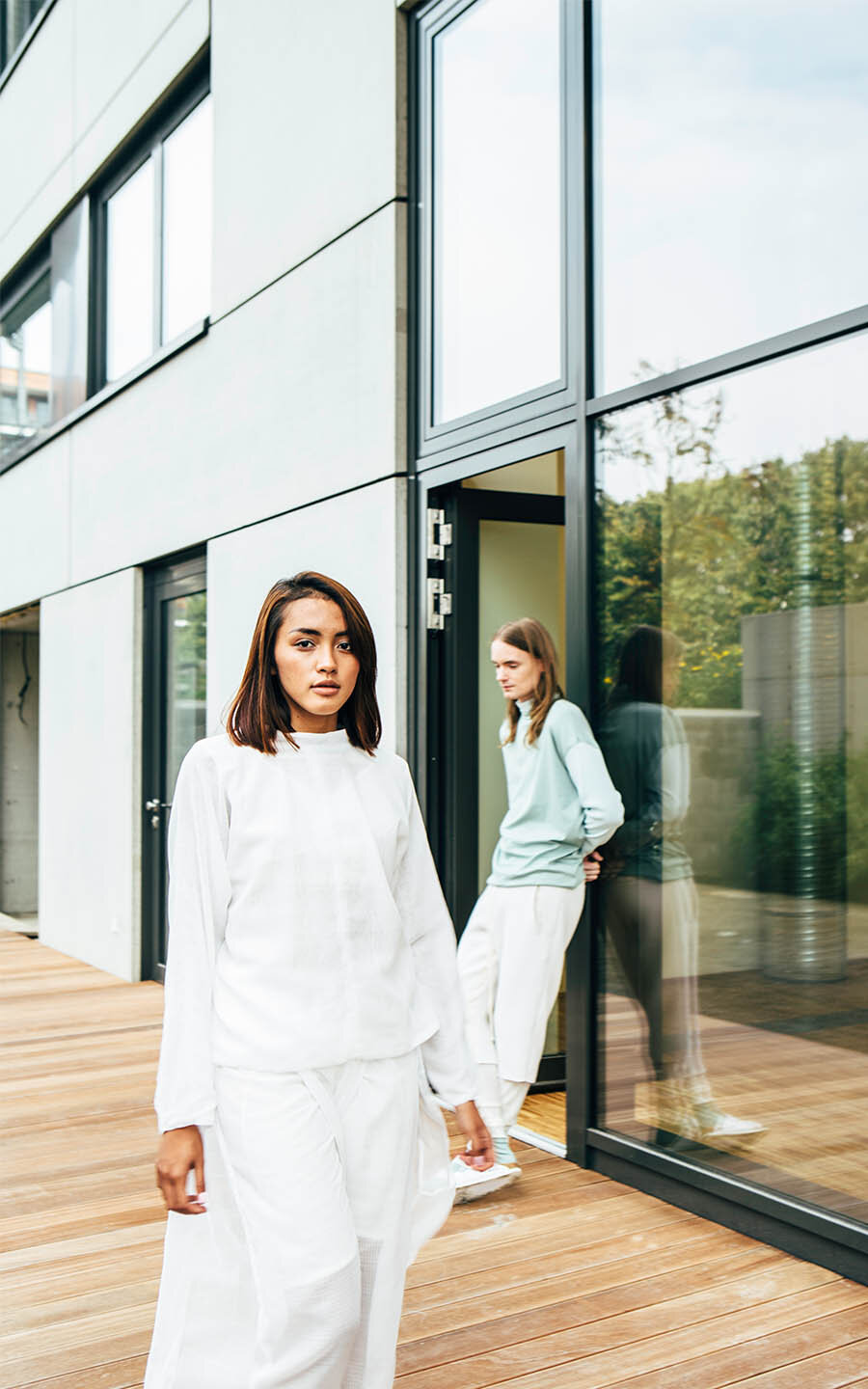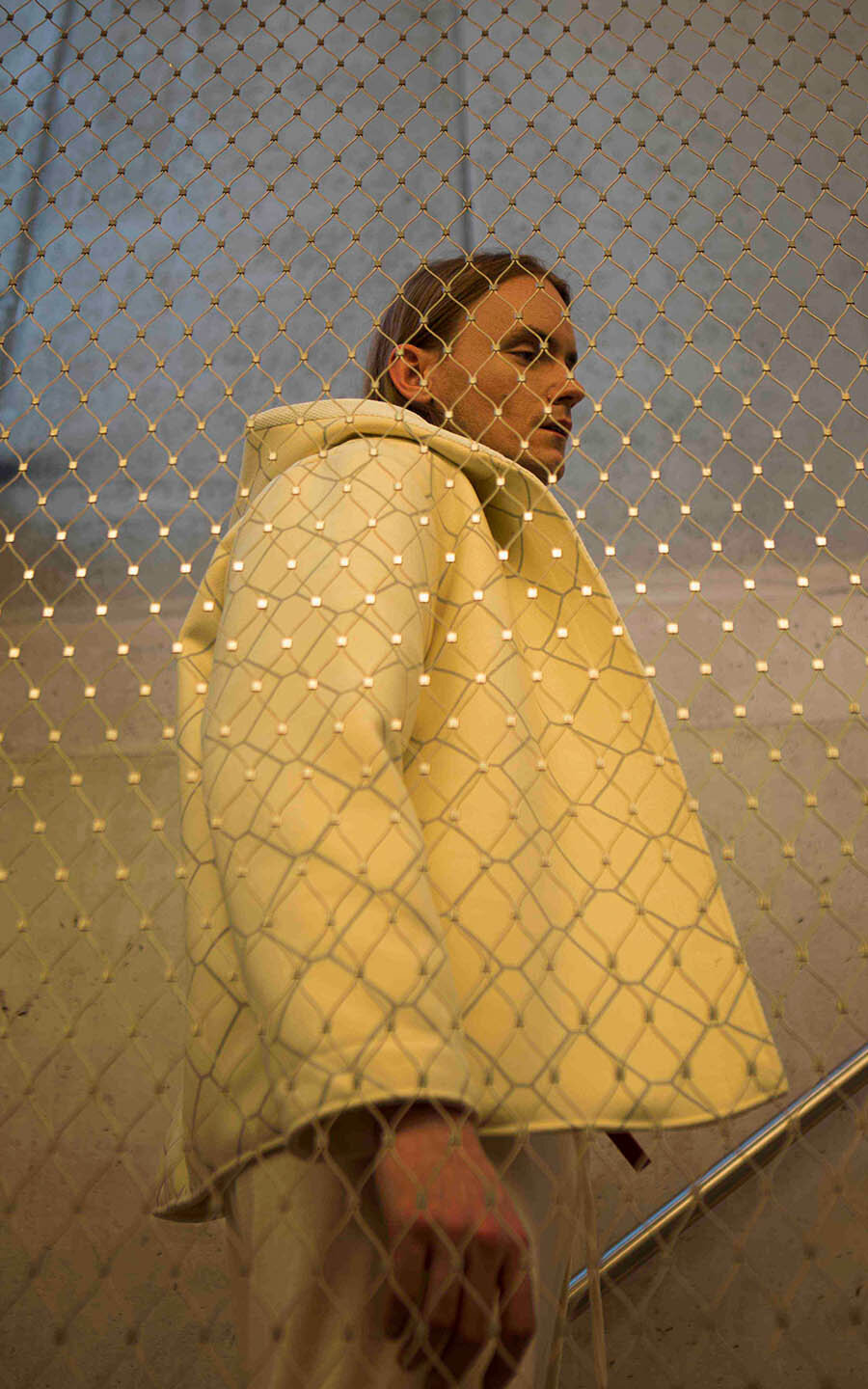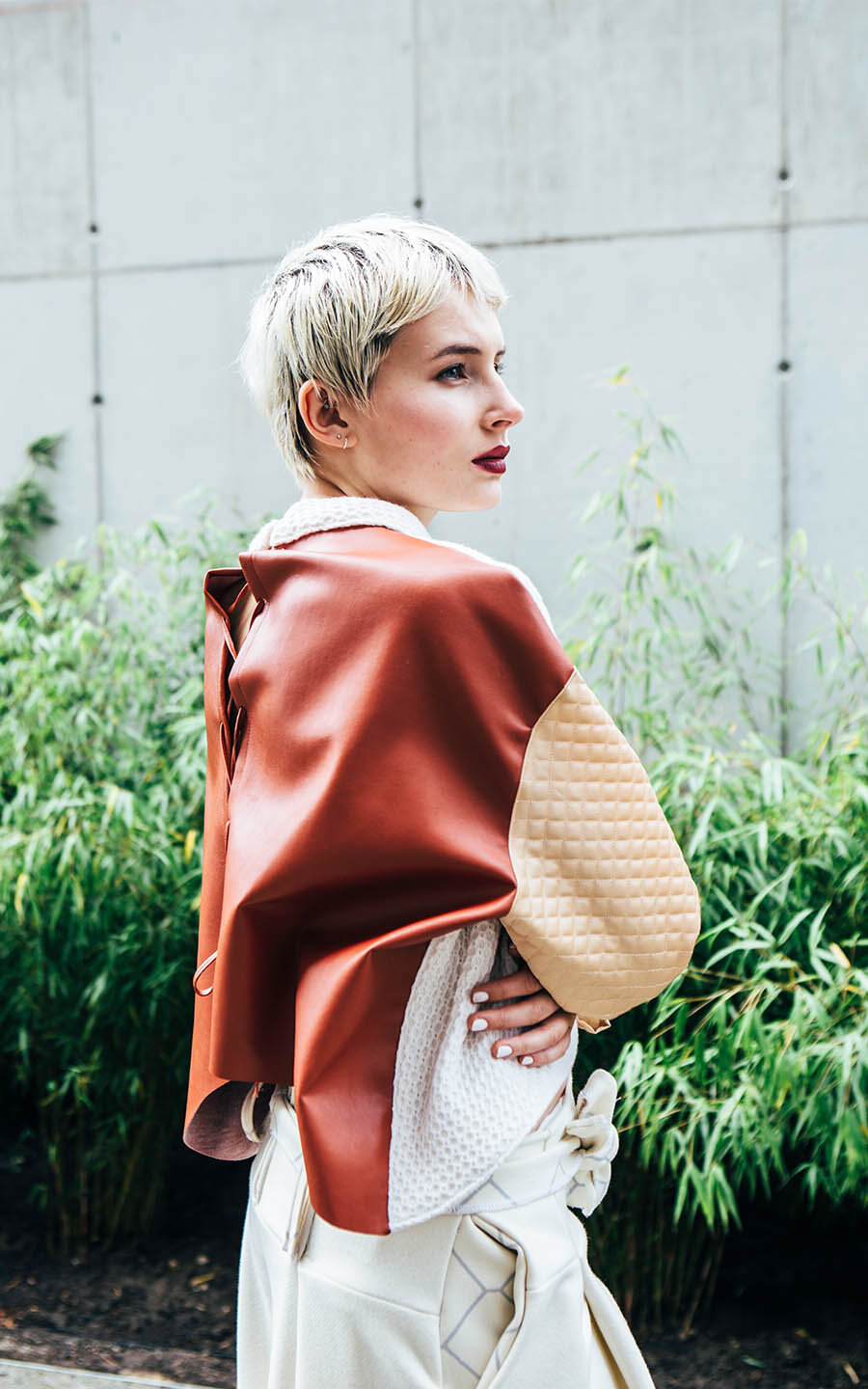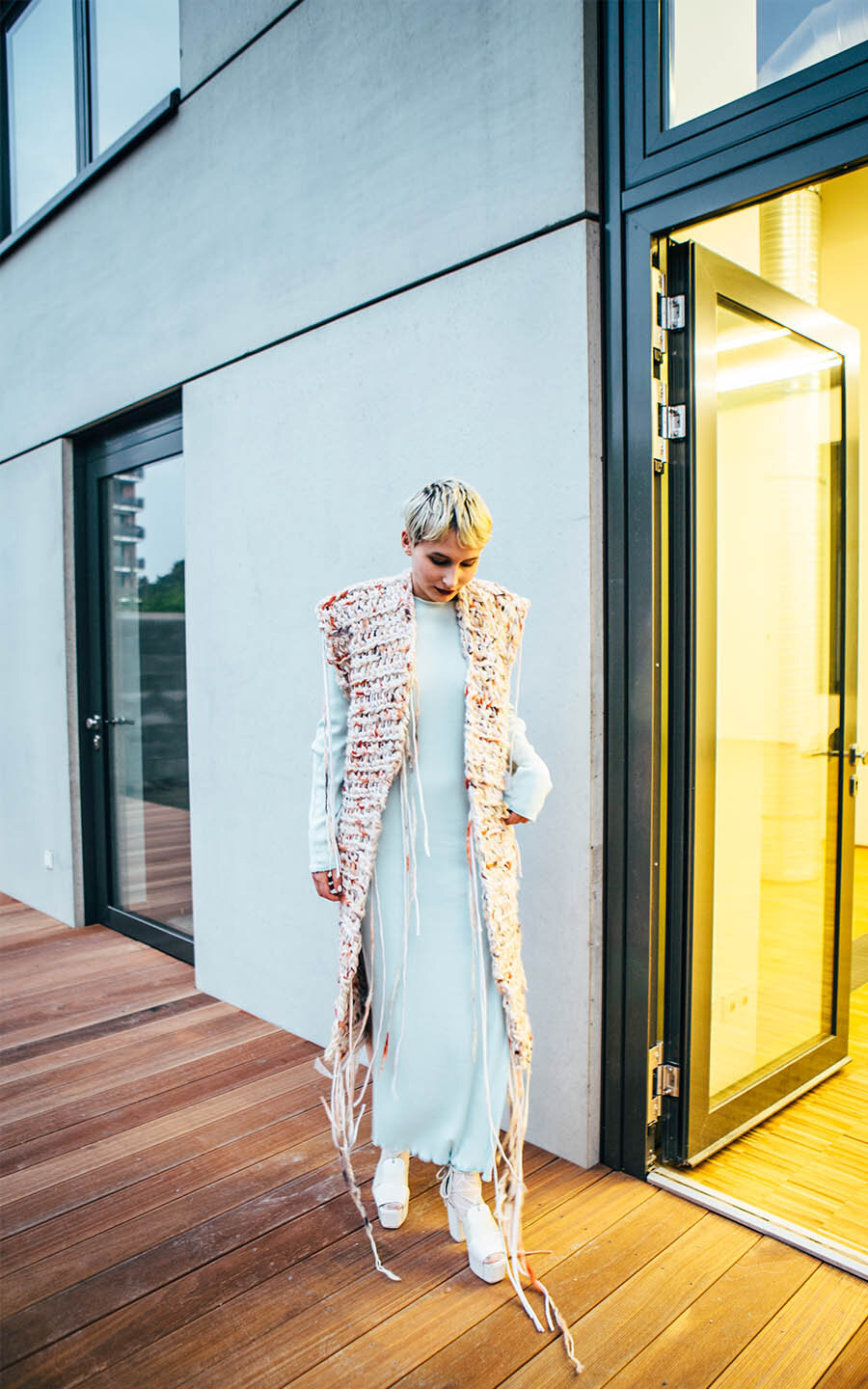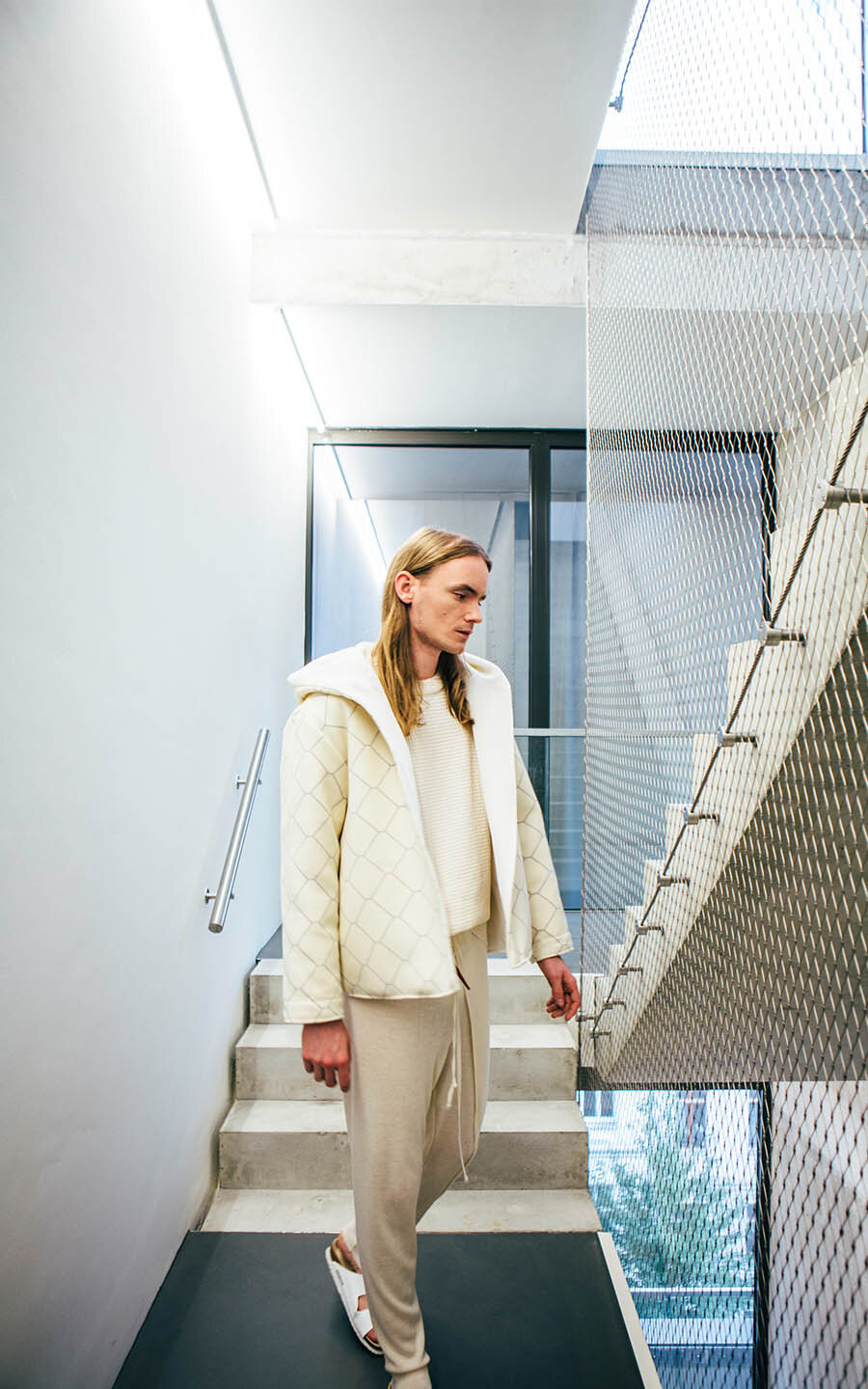Navigating Life During a Pandemic Change
Reinventing our feeling of home and a shift towards fashion consciousness while facing a global collectiveness
Collection Dis/Placed designed and fabricated by designer Jana Hesse. Photos by Elina Abdrakhmanova. Model Vania Chinka. House S1516 Berlin.
With the occurrence of a global pandemic in spring 2020 our world hit rock bottom. No longer could we make decisions based on our own lives, but had to take responsibility for our actions affecting lives beyond our own. Through a rapid, rather unexpected stillness, everything was shaped by a big crash, leaving us home. For some that meant home, for others it meant a harsh stillness in a place that wasn’t home. Facing a new reality, which asked each of us to think globally and collectively, meant a drastic reinforcement of change and unexpected dynamics questioning everyone's tomorrow.
The pandemic redefined our relationship with space and identity. Space suddenly became the most dominant W-question of current times - WHERE shaped by the words: Spread, close, near, hot spots, proximity.
Not long ago, it sometimes felt as if our perception and connection to geography were blurred by endless opportunities in a globalized world. We can order across countries, fly to any possible destination, video call to family and friends on different continents and dive into others' lives through social media.
Now, in some ways, space has been reduced to the smallest scale. Safety, being defined by geography. On the contrary, space has been enlarged through the sense of decision-making on a global scale, forcing us to think collectively. The outcome of global connectivity through technology is keeping us together, while at the same time we are bound to the present, detained within our own four walls immobilized by uncertainties.
Home - NOW - a place within
Long ago, I came to realize that home for me, was no longer a feeling attached to a place, a location, a city...but more of a decision of warmth and belonging, rather it meant feeling part of a community, family, work ethic or one with nature. Home - the smell of food or the forest, the smell of grandma or the taste of chocolate chip cookies.
Having moved many times in the last ten years, I have come across multiple homes, multiple I’s and multiple feelings. I still feel I haven’t encountered this complete feel- ing of home and belonging in a singular place. I never really felt I had to choose, leaving possibilities open and limitless. I am fully aware of this being a privilege and shaping my idea of home in a way of my own, which can’t be projected onto anyone else.
Throughout this journey, I have come to realize that home is a sense we can encounter within, regardless of geographic space. Strangely enough, I have often felt the closest feeling of home after having left a place and then having returned, reminding me of why this place felt like home.
“And home, we know, is not just the place where you happen to be born. It’s the place where you happen to become yourself. “ Pico Iyer
Freedom enables us to see a new concept of the world that has been pieced together creating our own identity from multiple possibilities and homes. This can be the new concept of modernity (...) “one who doesn't attach his heart too tightly to things and places”. Byung-Chul Han. Nevertheless, the pandemic twisted new realities and evoked a feeling of returning home or creating a "home-like" space to protect us and indulge in.
Digital Globalization - being anywhere but here
Lockdown cocooning has changed our relationship to a comfortable home zone. The sheer impossibility of planning shifted our focus to the here and now, the actual only true importance in life.
Global communication, made possible through technology, has enabled unlimited possibilities in communication. The boundaries of space and time have blurred our vision, distorting present. Social media has shifted our focus to the lives of others led by FOMO, while our own drifts by.
Nevertheless, we are physically in a different place, but mentally and psychologically we may still be “at home”. Which leads to a never-ending story of missing out on the perks of fully living in the moment. Due to the new possibilities and world-views, as a result of technology and globalization, the term home has become controversial and the understanding of it has shifted.
Does home still have any meaning for us? Is it possible for us to own not just one home, but countless homes? Or is home just a feeling that is not tied to either place or time?
All who wander are not lost
The room has no walls, so to speak. According to the philosopher Byung-Chul Han, this can be seen as a positive as well as a negative development. On the one hand, he argues that this rapid increase in options and unlimited freedom of physical as well as psychological limits causes a new phenomenon of emptiness and directionless "swimming around" in a "hyperspace" (hyperculturality) a “horizon collapse”. That means, in the so-called “hyperspace” the relationship to rationality and footing disappears. So we lose ourselves in many possibilities and become disoriented.
No longer being afraid to cross physical boundaries, nor being dependent on a particular place we swing our lives as “nomadic” characters, corresponding very closely to that of a modern cosmopolitan. Referring to a “hyperindentity"(Byung-Chul Han) a “patchwork-like structure” forming one big entity through many little particles, makes us wanderers. However, “all who wander are not lost.”
The longing for a safe place in times of crisis reflects the vulnerability of humanity. “Heimat” is a German word lost in translation. In the Covid 19 pandemic, people are looking for emotional refuge - but at the same time, home threatens to be lost as a shared place of life.
Crochet jumper in off-white combined with wool underwear and wide fence trousers. Photo by Elina Abdrakhmanova. Model Sabina Schimanowski.
Rebirth of Home - Cocooning
I just want to stimulate thought and make one or the other aware of their surroundings and themselves. I encourage you to concentrate on the moment and to perceive the time / present more consciously - with its advantages, but also the associated disadvantages.
We are facing a time, different from the previous one, but are only on a stopover on this earth. Even in the midst of uncertainties, the longing for the good old past and great efforts to obtain a better future, still reflect our absence of the now. Home - no different from any given moment of our lives means-being in the present and refusing our lives to pass by with eyes shut. The topic dis/placed is neither a topic that specifically inspires fashion nor a topic that already exists as a concept. But it is a socially critical topic of the present that has already been researched by various philosophers, writers and scientists.
If you refer to home positively, and by positive I don't mean in the nationalistic sense, then this is a place that is often linked to the place of birth, to the place of origin. Which, when things go well, is connected to an innocent world of childhood, in which one felt safe and secure, where there is a kind of quiet everyday life. Home then consists of familiar noises, smells and tastes and above all space, space in the where and space in landscapes. Where you know each other in the best sense of the word, where you feel confidence, friends who live in the same place, who help, where you feel understood as well as comfortable and safe.
So how has the pandemic shifted the sense of home? What does home look like now? A place of comfort and warmth - how can we picture ourselves when work blends with the home, when our home becomes our office? A pandemic ruling our lifestyle and interfering with our personal space has not only held a great influence on our perception of the planet, but also influenced consumerism. No longer do we want to be uncomfortable to look good, or careless about synthetic unknown materials covering our skin. We are looking for solutions that overcome “fast fashion”- fast solutions and their tremendously devastating outcome for our planet.
Transparent Loungewear worn by Model Vania Chinka. Photo by Elina Abdrakhmanova.
Stillness Awakening Fashion Consciousness
Devastating news of civil war, fires raging across the Amazon, impacts of drought on poverty and the collapse of the fashion factory building Rana Plaza in Bangladesh leave many untouched. The human consciousness hardly awakens before facing tragedies first hand. The pandemic forced us to face a new challenge and change under circumstances of stillness. No distractions of shopping malls, movies and open stores and cafes, to keep consuming without the necessary awareness.
The latest results in fashion have shown that the demand for sustainability in fashion consumption has increased since the pandemic. Most people have had the time to wind down and check what’s important in their lives and question the outcome of personal behaviour affecting our planet. The resources are increasingly scarce and con- sumers are starting to understand the damage resulting from fast fashion. All in all fashion culture is a reflection of our time and everyone knows by now that young generations are leading with a powerful drive for nurturing and protecting our planet for the future.
The only way fashion can be changed is by spreading the knowledge of the importance of slow fashion, increasing the awareness and engagement of questioning the “origin”of the product.
“Every product comes with a climate cost,”
but what would it be like to imagine a world where every piece of clothing comes with a story behind it- where the very garment has a carbon tag to show us its impact.
Those who have little are being exploited by systems that reflect the blindness of consumers and intoxication of brands using greenwashing strategies.
Sustainability and fashion meet on many levels. Fashion is future-oriented, always looking for new trends and ideas. It is precisely this aspect that connects fashion with sustainability, which is concerned with the future and the protection of our planet and our people. Like many other things, fashion is inferior to acceleration. Like everything else, it is ephemeral and retreats with the times - that is, the seasons are getting shorter and shorter and fashion is getting faster and faster. Leaving us with decreased quality and short-lived pieces, that turn into low-quality garbage, hard to recycle.
In future we will not access nature as we did before and only use plant-based materials such as organic cotton, hemp and organic silk, but will increasingly focus on new alternatives made possible through technology and adjusting the fashion supply chain. Just a few examples of alternatives: Clothing made from food, recycled PET fabricated into beautiful high-quality yarns, 3D printing and product development- with minimal waste outcomes, saving the lives of animals through high-tech vegan fabrics from yeast cells...
Comfortable wool, feel good fabrics, loose cuts - some of the trends might change our idea of what to wear to work. Lounging around in faded T-shirts and track pants, while women opting for Patiala pants, Kurtas, and comfortable cotton twinsets, leaving the house with our good old Birks and swinging the tracksuit as a business combo two- piece on a video call.
Spreading the knowledge of the importance of slow fashion. Increasing the awareness and engagement of questioning the “home” of the product.
Let's have hope, that this is a long-lasting trend, changing the fashion industry for good. Let's hope our new levels of collectiveness and returning to “home” as a base of morality and virtue bring goodness to our future fashion culture. The global fashion industry was affected in many ways, demanding new solutions and a sense of creativity in having to express in a limited geographical zone, not allowing movement in a geographical sense for shows and photo shoots. As a result, new opportunities have risen leading to a shift of what might be possible to stay.
Collectiveness to shape a better tomorrow
All of this is nothing new. But due to the pandemic an emphasis on consciousness and collectiveness has led to the questioning of our internalized behavioral structures and thoughts. We often seem to forget how much impact each one of us has on the environment and humanity. If we could act and think globally and be careful and respectful in our actions of not harming mother earth and the feelings of the ones around us, we would shape a future home.
For climate change is not only a matter of causing ocean currents, elevation and temperature increase, but as a matter of fact, is affecting human rights - human equality.
Home- a space within and surrounding you came to a stillstand, leading us to question the former outcome of decisions and bringing us down to earth enabling a return to our natural intuition, emphasizing the importance of hope within, as well as through adjusting our behavioural patterns to serving a better future for a planet long calling for collectiveness and unity. I embrace this change evolving from the global pandemic with careful hope and a critical eye, questioning the endurance of a positive trend towards conscious living and consuming.
Hope in the now- staying home and hoping for our mental as well as physical wellbeing, sustaining hope, even through difficult times, asks for courage and creativity, reframing our thoughts to shift awareness towards conscious living. Years of resilience and hope, because deep down, what we imagine we can create, and what we create, forms our now and yet to be…
As each of us contributes to the now, in small as well as in big ways, to shape a better tomorrow.
A story by Jana Hesse









